

?Supporters and opponents debated the pros and cons to changing the rule that determines how to properly classify employees and independent contractors during a U.S. House Education and the Workforce Committee hearing on April 19.
“The independent workforce is growing, and it’s here to stay,” said Tammy McCutchen, a senior affiliate at Resolution Economics, a Los Angeles-based provider of litigation consulting and expert witness services.
Congress is considering the PRO Act, legislation that would make it more difficult for employers to classify their workers as independent contractors, who are not covered by the National Labor Relations Act (NLRA).
In October 2022, the U.S. Department of Labor (DOL) issued a proposed rule to clarify who is an independent contractor under the federal Fair Labor Standards Act, potentially affecting the gig economy.
The DOL is proposing to rescind a 2021 rule in which two core factors—control over the work and opportunity for profit or loss—carried greater weight in determining the status of independent contractors. Under the new proposed rule, employers would use a totality-of-the-circumstances analysis, in which all the factors do not have a predetermined weight.
Supporters of Tightening the Classification Rule
Supporters at the hearing argued that the classification rule should change to protect more workers and make a more level playing field for all employers. Independent contractors are not entitled to overtime pay, minimum wage protections, workers’ compensation or unemployment benefits.
“For decades, unscrupulous employers have used misclassification as a strategy to cut down on labor costs. Low-road employers that misclassify workers gain an unfair competitive advantage. They have no incentive to invest in training their workforce, to be safer and more efficient, and they create hazardous situations on the jobsite,” said Rep. Alma Adams, D-N.C.
David Long, chief executive officer of the National Electrical Contractors Association in Washington, D.C., said, “In the construction industry, misclassification is a choice to disregard the legal responsibilities of being an employer or an employee. It provides a competitive advantage by failing to ensure the financial obligations are met that responsible businesses do every day.”
Laura Padin, director of Work Structures for the National Employment Law Project in New York City, agreed: “Misclassification is hurting businesses that play by the rules.”
Some freelancers and independent contractors make a lot of money, while others struggle to live paycheck to paycheck. Employers that misclassify independent contractors “depress wages and working conditions and shed responsibilities for their workers while maintaining control over key decisions, such as where, how and for how much money workers perform their jobs,” Padin said.
Misclassification is especially prevalent in low-wage industries, she said, and many janitors, home health workers, nail salon workers and delivery workers “are not actually running their own business, but rather accepting working conditions imposed on them by the businesses misclassifying them.”
Opponents
Opponents argued that tightening the classification rule would result in lost jobs and lost income for freelancers and independent contractors.
Rep. Kevin Kiley, R-Calif., said the Biden administration “has launched a multipronged assault on the right to earn a living in America. It is a concerted strategy designed to limit or eliminate the gig economy, freelancing, independent contracting, self-employment and alternate work arrangements that entire careers are based on and entire industries have been built around. The livelihoods of millions of Americans are at risk.”
Some gig workers want to be employees, while others prefer to remain independent contractors because of the autonomy and flexibility in hours. Independent contractors generally have more flexibility than employees, while employees have more employer-offered benefits and legal protections.
“The independent workforce is the right choice for many workers, but too many regulators want to take that choice off the table. Even with the tradeoffs, choosing the freedom and flexibility of independent work over being controlled by an employer is a rational choice,” McCutchen said.
Many gig workers also have full-time jobs elsewhere, said Liya Palagashvili, senior research fellow and economist at George Mason University in Fairfax, Va. “At first glance it seems like a win for those who might be reclassified as employees and receive benefits; however, that is unlikely to be the case for the majority of workers. That’s because it’s impossible for every independent work opportunity to turn into a full-time job offer,” she said.
She expressed concerns about a possible recession this year. “Workers turn to independent work after they have faced the loss of income or unemployment. Independent work opportunities are critical for financially strained workers when they face economic hardship. At a time when employment opportunities are likely to become scarcer, it is unwise for the DOL to also limit independent work opportunities,” she said.
Because of the different ways federal and state laws define employees and independent contractors, it can be confusing for companies.
“There is no predictability [in the legal compliance], and that is what businesses fear,” McCutchen said. “We need one clear and simple rule,” instead of different definitions in different federal and state statutes.
